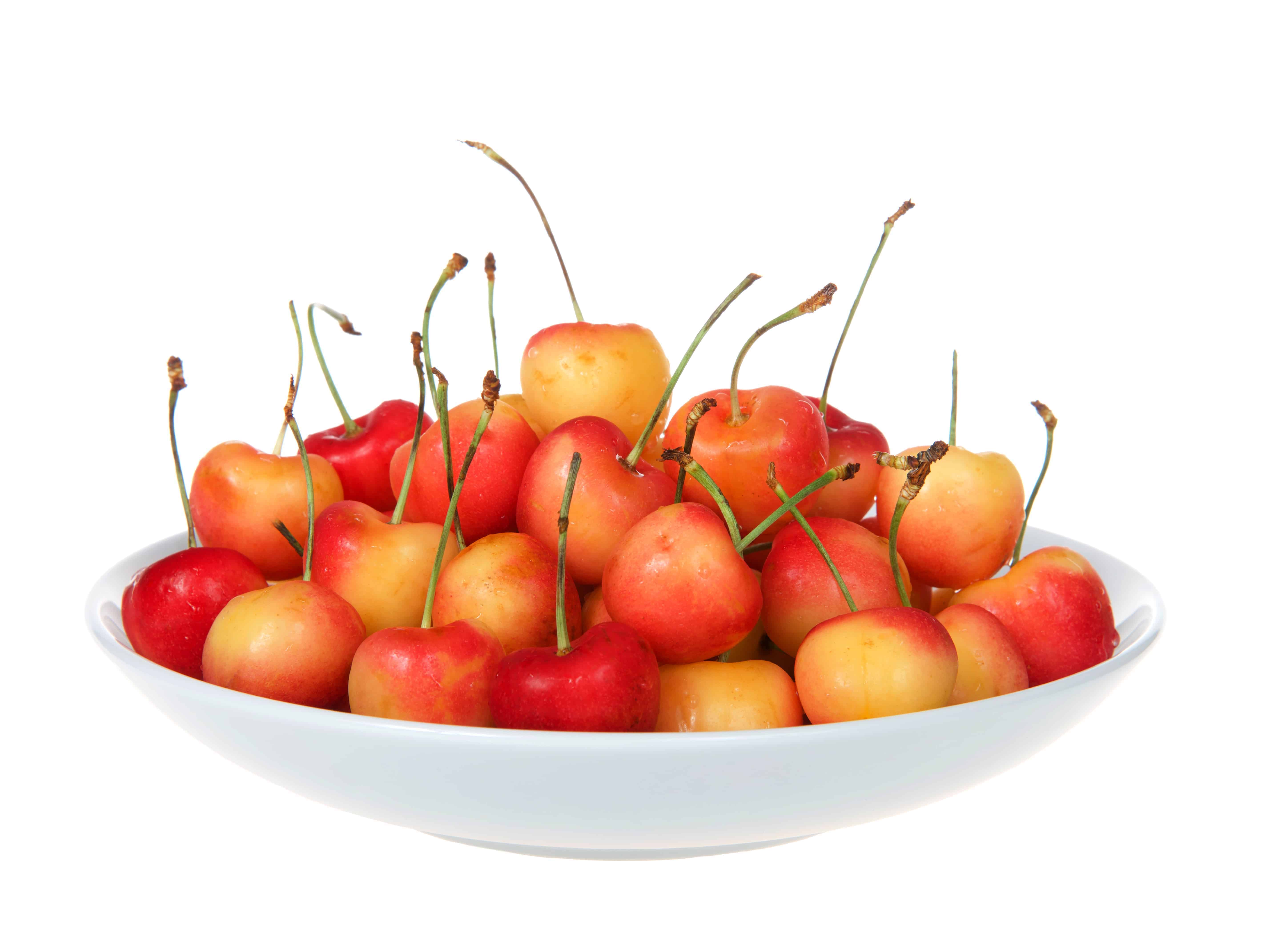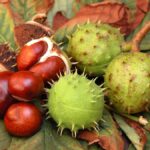Cherry season is short and sweet.
Well, the sweet cherry season is short and sweet, and the sour cherry season is short and tart.
Put the two seasons together and you can enjoy about four months of fresh cherries each year: sweet cherries for eating out of hand and using in fruits salads, compotes, custards, sorbets, ice cream, and yogurt; sour cherries for pies, cobblers, clafoutis, dessert sauces, preserves, and jams.

Sweet cherries ripen from May through early July and sour cherries ripen from mid-June through mid-August. The peak season for cherries in the Southern Hemisphere is during December.
There are more than 500 varieties of sweet cherries and more than 300 varieties of sour cherries. In the middle are a host of hybrid varieties known as sweet-sour cherries.
Sweet cherries
Sweet cherries are sweet and fleshy, usually light or dark red and sometimes yellow-skinned. Sweet cherries can be round, oblong, or heart-shaped. They are usually eaten out of hand or added raw to fruit salads and desserts.
Sweet cherries can be classified into two main groups. The first is known as bigarreaus which have sweet, firm, dry flesh and include the varieties Bing, Lambert, Napoleon (also called Royal Ann), Rainier, and Schmidt. The second is known as geans (guignes in French) or heart-shaped cherries. These cherries are soft fleshed and juicy. Black Tartarian is a heart-shaped cherry.
Sweet cherries today are descended from wild sweet cherries which were known to the ancient Egyptians, Greeks, and Romans. Wild cherries can still be found today; they are small, almost back in color, and not very fleshy. Wild cherries can be used in tarts and for preserves such as jams, liqueurs, and syrups.
Sour cherries
Sour cherries–also called pie cherries or griottes in French–are medium- to small-sized cherries with dark red skins. Sour cherries are almost always cooked and not eaten raw.
Sour cherries are usually classed into two groups. The first is known as the amarelle group. Amarelle sour cherries have yellow flesh and clear juice. Amarelle varieties include Montmorency, Early Richmond, and Meteor. The second group is known as morello cherries. Morello sour cherries have red flesh and red juice. Morello varieties include the named varieties English Morello and Morello.
Sweet-sour cherries–also known as Dukes and Royals–are crosses between sweet and sour cherries. Sweet-sour hybrids can be used for both eating out of hand and cooking, but their flavor is closer to the sour cherry than the sweet cherry. Governor Wood is a sweet sour or Duke cherry.
Ways to serve cherries
Cherries can be eaten raw, cooked, candied, dried, preserved in syrup, macerated in alcohol or distilled.
- Use raw fresh sweet cherries in compotes, fruits salads, custards, sorbets, ice cream sundaes, yogurt, tarts, pies, flan, soufflés, and clafoutis.
- Dried cherries are usually dried Bing cherries or sweetened tart cherries.
- Sour cherries are used in cooking. They can be used for preserves, in syrup or brandy, candied, and jams.
- Vinegared sour cherries are a piquant garnish for pâtés and other cold meats.
- Sour cherries are used as a base for liqueurs and alcoholic drinks such as English cherry brandy, Guignolet, and Kirsch from France, and Maraschino from Italy.
- Maraschino cherries are any variety of cherry–usually Royal Ann–that have been pitted and macerated in flavored sugar syrup and bitter almond. Maraschino cherries are used to garnish desserts and cocktails and in baked goods and fruit salads.
How to choose cherries
Select cherries that are plump, firm, bright-colored, and glossy-skinned: the deeper the color, the sweeter the taste. If the stems are attached, they should not be dried out. (Cherries store better with their stems attached.) White or light-colored cherries should be firm and unblemished with a blush of color.
Avoid unripe cherries; they will be small, pale, and hard. Avoid overripe cherries with soft brownish spots.
Cherries do not ripen after harvest, so choose cherries that are ready to use.
How to store cherries
Sweet cherries will keep in the refrigerator in a perforated plastic bag for 2 to 3 days. Sour cherries will keep in the refrigerator for up to 2 weeks. Keep cherries away from strong-smelling foods; they will absorb odor and lose flavor. Cherries stored at room temperature will spoil rapidly.
You can freeze whole or pitted cherries for 6 to 12 months. To freeze cherries: rinse and dry, pit, and place in freezer bag leaving ½ inch (13 mm) of space. Frozen cherries can be coated with sugar or syrup before freezing.
Dried cherries will keep for about a year in an airtight container in a cool, dry place.
How to prepare cherries
Wash, do not soak cherries. For compotes and fruit salads remove fresh cherry stems then remove the pits with a cherry pitter or cut the cherry in half with a paring knife and remove the stone or make an incision at the top of the cherry tip and remove the stone.
Fresh sour cherries should be pitted before cooking.
Bland-tasting cherries can be marinated overnight in cherry juice or any berry juice, or in sugar-sweetened brandy, or in red wine. Marinated cherries are best served warmed up in a saucepan.
Cherry flavor partners
Cherries have a flavor affinity for almonds, chocolate, cinnamon, custard, duck, goose, kirsch, pork, poultry, red wine, sour cream, and yogurt.
Cherry nutrition
Sweet cherries are a good source of potassium. Sour cherries provide potassium, fiber, and vitamin A. One cup of fresh sweet cherries contains about 100 calories; one cup of fresh sour cherries contains about 50 calories.
About cherries
Cherries grow throughout the temperate world wherever winter temperatures are not severe and summer temperatures are moderate.
Cherry trees–which belong to the same stone fruit family that includes peaches, plums, and almonds–are long-lived and usually grow to about 30 feet tall, though they can grow much taller. Cherries have plum-like leaves and are deciduous.
The cherry blooms in late winter or early spring and fruits a few months later. The cherry fruit hangs on long, thin stems attached in clusters to the bark of branches. Cherries can be difficult to harvest because not all of the fruit ripens at the same time.
Cherries originated in northeastern Asia and have been in cultivation for more than 2,000 years. Cherries most likely spread throughout the temperate world via bird migrations.
The word cherry comes from the Greek word kerasos which is derived from the name of a city in Asia Minor Cerasus (now in Turkey) where it is believed cherries were first cultivated. Kerasos became cherise in the old French language which in turn became the plural “cherries” in English.
The first cherry pie was baked in England during the time of Queen Elizabeth I.
The botanical name for sweet cherries is Prunus avium. The botanical name for sour cherries is Prunus cerasus.
Also of interest:
How to Plant, Grow, Prune, and Harvest Cherries
Related articles:
Planning the Home Fruit Garden
Garden Planning Books at Amazon:
- Vegetable Garden Almanac & Planner
- Kitchen Garden Grower’s Guide Vegetable Encyclopedia
- Vegetable Garden Grower’s Guide
- Tomato Grower’s Answer Book
More kitchen tips:
Bring your harvest to the table. Kitchen prep tips and easy recipes for the vegetables you grow. Click below for vegetable prep and recipes you can use now.
- Almonds
- Apples
- Apricot
- Aprium
- Artichoke
- Arugula
- Asparagus
- Avocado
- Bamboo Shoots
- Banana
- Basil
- Beans, Dried
- Beans. Long
- Beans, Shell
- Beans, Snap
- Beets
- Bitter Melon
- Blackberry
- Bok Choy
- Broccoli
- Broccoli Raab
- Brussels Sprouts
- Cabbage
- Cardoon
- Carrots
- Cauliflower
- Celeriac
- Celery
- Chard
- Chayote Squash
- Cherimoya
- Cherries
- Chestnut
- Chickpea
- Chinese Cabbage
- Chives
- Cilantro
- Citron
- Clementine
- Collards
- Coriander
- Corn, Sweet
- Corn, Baby
- Corn Salad, Mache
- Cranberry
- Cress
- Cucumber
- Daikon
- Dandelion
- Dill
- Eggplant
- Endive, Belgian
- Endive and Escarole
- Fava Beans
- Fig
- Florence Fennel
- Garlic
- Ginger
- Grapefruit
- Grapes
- Guava
- Horseradish
- Jerusalem Artichoke
- Jicama
- Jujube
- Kale
- Kiwifruit
- Kohlrabi
- Kumquat
- Leeks
- Lemongrass
- Lemons
- Lettuce
- Lime
- Mache (Corn Salad)
- Mandarin Orange
- Mango
- Maple Syrup
- Marjoram
- Melons
- Michihili
- Mint
- Mizuna
- Mushrooms
- Mushrooms, Cremini
- Mustard Greens
- Napa Cabbage
- Nectarine
- Okra
- Olives
- Olive oil
- Onions
- Oranges
- Oregano
- Parsley
- Parsley Root
- Parsnips
- Passion Fruit
- Pawpaw
- Peaches
- Pears
- Peas, Garden Snap
- Peas, Snow
- Pei Tsai
- Peppers, Chili
- Peppers, Sweet
- Persimmon
- Pineapple
- Pineapple Guava
- Plantain
- Plums
- Pluots
- Pomegranate
- Potatoes
- Prickly Pear
- Pumpkin
- Quince
- Radicchio
- Radishes
- Raspberries
- Rosemary
- Rhubarb
- Rutabaga
- Sage
- Salsify
- Sauerkraut
- Savory
- Shallots
- Sorrel
- Spinach
- Squash, Summer
- Squash, Winter
- Strawberries
- Sunchokes
- Sunflower
- Sweet Potato
- Swiss Chard
- Tangerine
- Taro
- Tarragon
- Thyme
- Tomatillo
- Tomato
- Turnip
- Turnip Greens
- Yams















